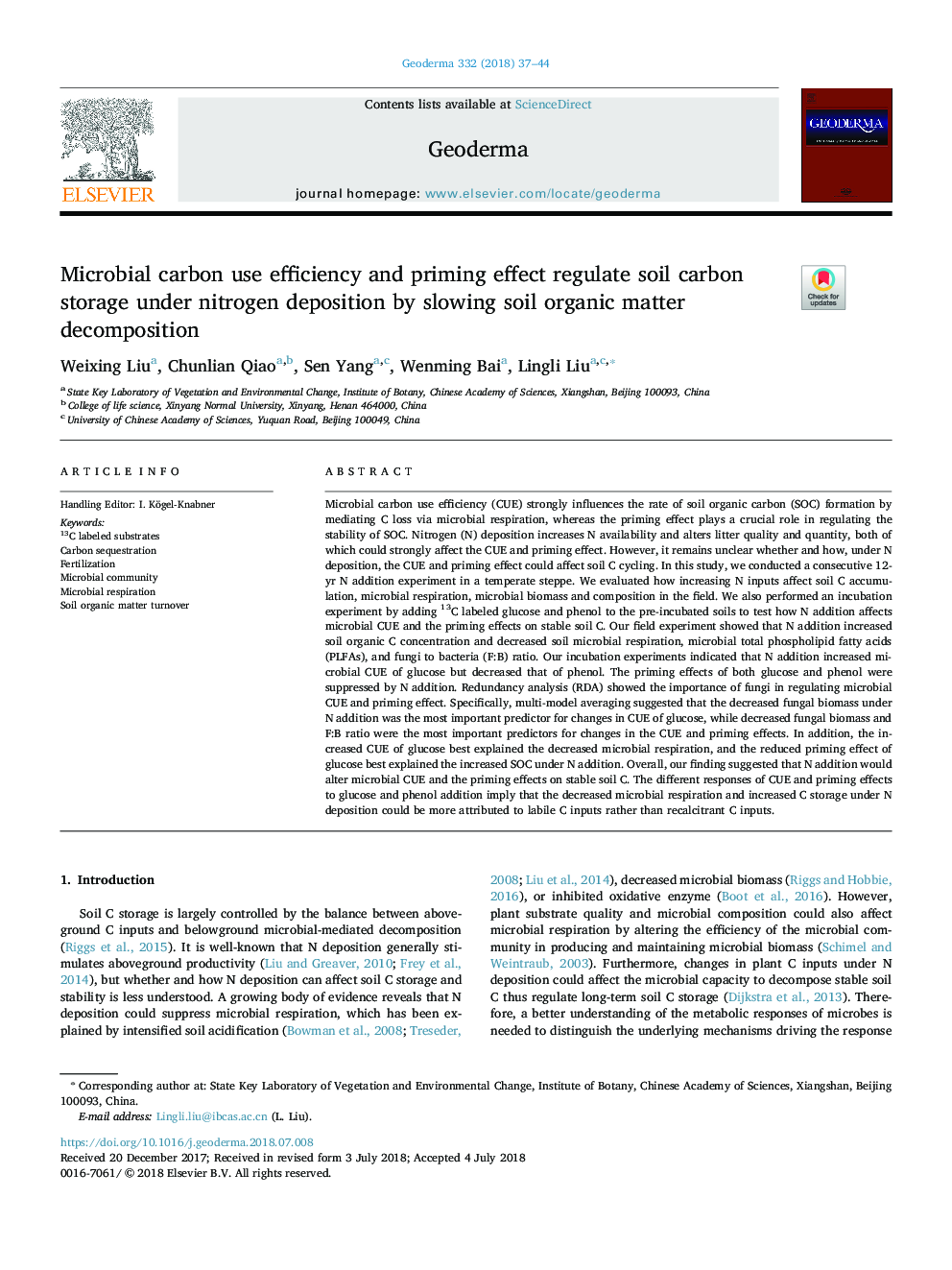| کد مقاله | کد نشریه | سال انتشار | مقاله انگلیسی | نسخه تمام متن |
|---|---|---|---|---|
| 8893869 | 1629385 | 2018 | 8 صفحه PDF | دانلود رایگان |
عنوان انگلیسی مقاله ISI
Microbial carbon use efficiency and priming effect regulate soil carbon storage under nitrogen deposition by slowing soil organic matter decomposition
ترجمه فارسی عنوان
کارایی استفاده از کربن میکروبی و اثر پارتیشن بندی ذخیره سازی کربن خاک تحت رسوب نیتروژن با کاهش تولید تجزیه مواد آلی خاک تنظیم می
دانلود مقاله + سفارش ترجمه
دانلود مقاله ISI انگلیسی
رایگان برای ایرانیان
کلمات کلیدی
موضوعات مرتبط
مهندسی و علوم پایه
علوم زمین و سیارات
فرآیندهای سطح زمین
چکیده انگلیسی
Microbial carbon use efficiency (CUE) strongly influences the rate of soil organic carbon (SOC) formation by mediating C loss via microbial respiration, whereas the priming effect plays a crucial role in regulating the stability of SOC. Nitrogen (N) deposition increases N availability and alters litter quality and quantity, both of which could strongly affect the CUE and priming effect. However, it remains unclear whether and how, under N deposition, the CUE and priming effect could affect soil C cycling. In this study, we conducted a consecutive 12-yr N addition experiment in a temperate steppe. We evaluated how increasing N inputs affect soil C accumulation, microbial respiration, microbial biomass and composition in the field. We also performed an incubation experiment by adding 13C labeled glucose and phenol to the pre-incubated soils to test how N addition affects microbial CUE and the priming effects on stable soil C. Our field experiment showed that N addition increased soil organic C concentration and decreased soil microbial respiration, microbial total phospholipid fatty acids (PLFAs), and fungi to bacteria (F:B) ratio. Our incubation experiments indicated that N addition increased microbial CUE of glucose but decreased that of phenol. The priming effects of both glucose and phenol were suppressed by N addition. Redundancy analysis (RDA) showed the importance of fungi in regulating microbial CUE and priming effect. Specifically, multi-model averaging suggested that the decreased fungal biomass under N addition was the most important predictor for changes in CUE of glucose, while decreased fungal biomass and F:B ratio were the most important predictors for changes in the CUE and priming effects. In addition, the increased CUE of glucose best explained the decreased microbial respiration, and the reduced priming effect of glucose best explained the increased SOC under N addition. Overall, our finding suggested that N addition would alter microbial CUE and the priming effects on stable soil C. The different responses of CUE and priming effects to glucose and phenol addition imply that the decreased microbial respiration and increased C storage under N deposition could be more attributed to labile C inputs rather than recalcitrant C inputs.
ناشر
Database: Elsevier - ScienceDirect (ساینس دایرکت)
Journal: Geoderma - Volume 332, 15 December 2018, Pages 37-44
Journal: Geoderma - Volume 332, 15 December 2018, Pages 37-44
نویسندگان
Weixing Liu, Chunlian Qiao, Sen Yang, Wenming Bai, Lingli Liu,
